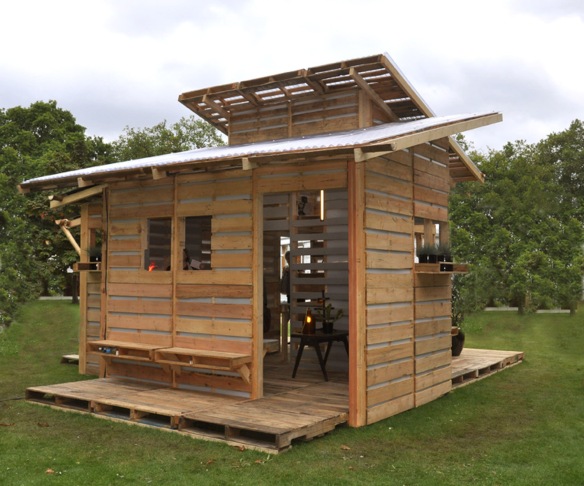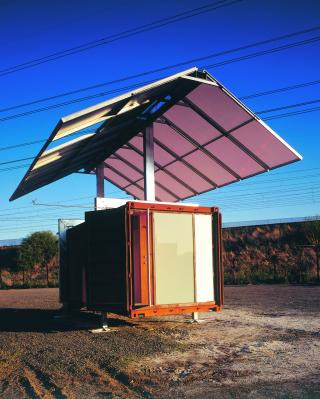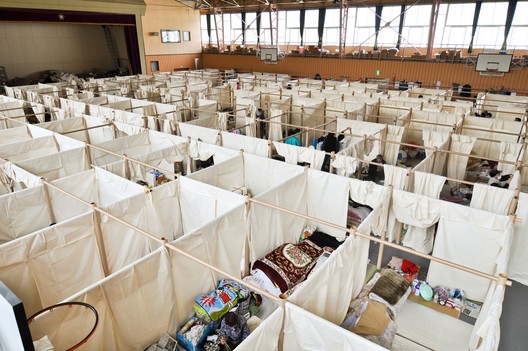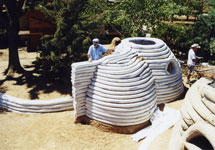Pallets, containers, tyres, straw, earth. And other stuff nobody wants. Or do they….
Quoting from one designer, “pallets are typically available for free most anywhere in the world”. It is similarly frequently claimed that shipping containers are easy to come by and that tyres can be found by the thousand anywhere in the world. These materials, in most places vulnerable to disasters, are valued assets and certainly not free. Even if they were, the time it would take to collect them all would mean they are no use for rapid disaster response.
Pallet House
“The principal building module is the wooden shipping pallets which are versatile, recyclable, sustainable, easily assembled and inexpensive. They are readily available in most countries and their transportation cost and weight is negligible when used to carry shipments of clothing, food, medical supplies or other relief aid.”
“The Pallet House is an inexpensive, efficient and easily realizable solution to the problem of housing people displaced by natural disaster, plagues, famine, political and economic strife or war. It is intended to serve returning refugees who come home and find their house partially or fully destroyed. This type of transitional housing bridges the gap between temporary tent shelter and permanent home.”
A few of these have been built at exhibitions and other events, using donated materials. It has won several architectural awards. I believe it has yet to be built in a post-disaster context.

http://www.i-beamdesign.com/the-pallet-house-newyork/
Rescooz
“Rescooz® is more than just a shelter:
It gives refugees a private space that restores the sense of privacy, a sense of dignity and responsabililty because this shelter is the result of the work of the refugees themselves.
Light (the heaviest element weighs only 25 kg), simple and quick in its construction, RESCOOZ® is a 25 sqm shelter which is built the same day with reduced personnel and tools : a man, a screwdriver , a mallet, a saw and a level.”
My only comment on this: why can it only be built by a man? Is there something about the design that makes it impossible for a woman to build it?
http://www.sofrinnov.com/en/rescooz-kit/
Green Container International Aid
“Abandoned shipping containers present a viable answer to the lack of housing for displaced populations rendered homeless after natural catastrophes.”
Shipping containers typically cost over £2,000; much more for any kind of customisation. They are very rarely abandoned, and even if they are left somewhere, I bet you anything someone still owns them and doesn’t want you turning them into a house.
http://green-container-intl-aid.com/
Future Shack
The ‘Future Shack’ has a covered area of around 14.9m2, providing 3m2 per person for an average family of 5.
“A mass produced relocatable house for emergency and relief housing. Recycled shipping containers are used to form the main volume of the building. A parasol roof packs inside the container. When erected, the roof shades the container and reduces heat load on the building. Legs telescope from the container enabling it to sited without excavation on uneven terrain.”

http://www.seangodsell.com/future-shack
Origami Paper House
See Small Houses
Shigeru Ban Paper Houses
Shigeru Ban has designed and built a whole range of cardboard and paper buildings after disasters around the world. Projects vary from stunningly beautiful buildings like the cathedral in Christchurch and a church in Kobe, to simple tents such as those built in Rwanda in 1999.
The use of paper tubes isn’t really explained in most of the projects, although it’s explained on environmental grounds in Rwanda. It’s hard to imagine setting up a supply chain of suitable paper tubes is appropriate in so many circumstances, and none of the emergency shelter/housing projects made of paper have been delivered at any kind of scale.
A mention of the partition system used widely in Japan after the 2011 tsunami must be mentioned. Collective shelters after disasters are notoriously unsafe and undignified. Providing some degree privacy in such situations is important.

http://www.archdaily.com/489255/the-humanitarian-works-of-shigeru-ban/
http://www.shigerubanarchitects.com/works.html#disaster-relief-projects
Sandbags
Cal-Earth and several others have proposed structures built of sand-bags with barbed wire reinforcement for emergencies, and have produced a training guide. The buildings are claimed to be disaster-resistant and easy to build. However, they have never been used at any scale in emergencies, most likely because they are a completely unknown construction technology and leads to odd-looking and odd-shaped buildings. People in emergencies will tend to build what is familiar.

http://calearth.org/building-designs/emergency-sandbag-shelter.html
http://www.akdn.org/architecture/pdf/2761_Ira.pdf
See also http://www.earthbagbuilding.com/emergency/emergency.htm
